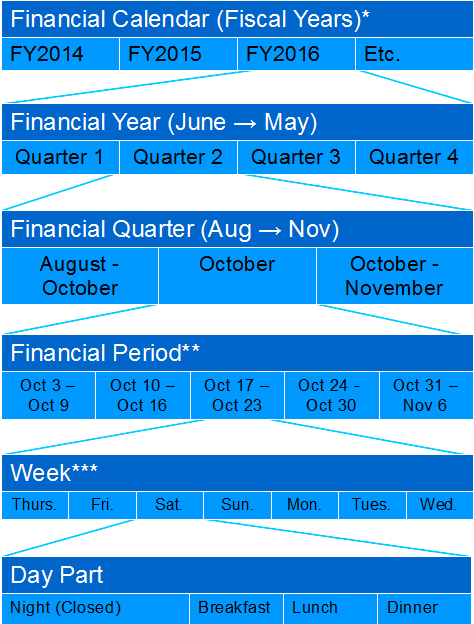Financial Calendars
The sales information received by Reporting and Analytics from the Point-of-Sale (POS) application is processed by each business day, as configured by the POS End-of-Day (or End-of-Night) operations. For example, if a store is configured to perform End-of-Day operations every night even when the store is closed on weekends, the POS creates Saturday and Sunday as business days with no sales values, resulting in a seven-day week. If a store is configured to perform End-of-Day operations every week day, the POS only creates Monday to Friday, and the empty sales values from Saturday and Sunday are rolled into Monday, resulting in a five-day week.
The Reporting and Analytics financial calendar organizes the business dates within the following defined fiscal year components:
-
The start and end of the fiscal year. Financial calendars also define how to handle the surplus day(s) at the end of the year.
-
The starting day of each week.
-
The start and end of each financial period.
-
The start and end of each financial quarter.
By defining the components, the financial calendar ensures that users know what to expect when viewing calculations or requesting calculations based on certain intervals. For example, a financial period always consists of four or five weeks, depending on the accounting cycle used, and always includes the same number of each day of the week, resulting in a meaningful comparison of values across periods. A calendar month can differ in the number of weeks and days, and can have different numbers of each day of the week, making comparisons across months much less reliable and meaningful.
The following illustration provides an example of the component layers that comprise a financial calendar:

* The financial calendar can be assigned to an organization level and location, with the location settings overriding the level settings. When using Analysis Reports, you must configure the system-generated Default Calendar.
** The length of a financial period depends on the accounting cycle selected for the financial year. Financial periods are defined by the number of weeks since the start of the financial quarter, and do not correlate to any one specific calendar month. In this example, all three financial periods in the financial quarter include at least one day in October.
*** Each financial week begins with the day of the week of the first business day of the financial year. For example, if a financial year begins Thursday, June 1, every financial week begins on Thursday and ends on the following Wednesday.